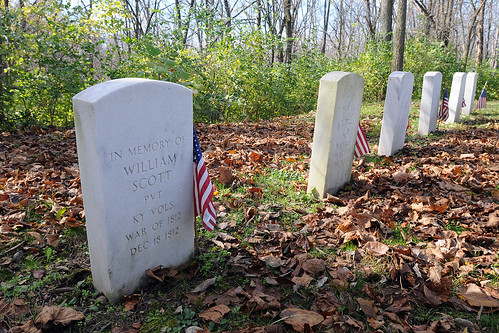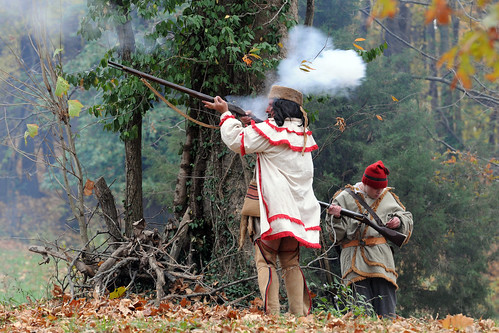This is Part IV of a five-part series documenting the travels of Kentucky Guard Command Historian, John Trowbridge as he explores Kentucky's participation in the War of 1812.
[caption id="" align="aligncenter" width="576"]

War of 1812 re-enactors participate in a mock battle during the Muster on the Wabash encampment in Vincennes, Ind., Nov. 3-4, 2012. (Kentucky National Guard photo by Sgt. Scott Raymond)
Story and photos by Sgt. Scott Raymond, Kentucky National Guard Public Affairs Office
VINCENNES, Ind. -- Studies of the War of 1812 popularly revolve around Fort McHenry and the Star Spangled Banner, the burning of Washington, D.C. and the Battle of New Orleans. History books in schools sometimes devote as little as a chapter, or less, to this pivotal conflict in our Nation's early years. And while the war is mentioned, places such as Mississenewa, Spurs Defeat, and to some, even Tippecanoe are just odd names lost in a "forgettable war".
To see more photos documenting Kentucky's involvement in the War of 1812, click here.
The War of 1812 is sometime referred to as the second American Revolution, and this could not be further from the truth for the frontiersmen and the militias far from the East Coast and the "memorable" pieces of the conflict. Thousands of Americans were on the move West, stretching the country's borders into territories that would later become Indiana, Illinois and Missouri. Citizens of Kentucky, the first state west of the Appalachians, were among them. Kentuckians would make up a large number of the militiamen securing the western theater against Native Americans allied with the British.
"We have taken the War of 1812 for granted," said Rich Ferguson, a historian and War of 1812 re-enactor from Howard County, Ind. "The War of 1812 is about the state of Kentucky and its about the western territories such as Indiana,"
[caption id="" align="alignright" width="350"]

Rich Ferguson, local historian points out details of the Mississinewa Memorial statue in Marion, Ind. Nov. 1, 2012. The statue memorializes the march of U.S. Forces and their Native American prisoners from Mississenewa in the winter of 1812.(Kentucky National Guard photo by Sgt. Scott Raymond)
While Ferguson admits that important actions took place elsewhere, he said Kentuckians in the western territories did all they could to make this part of the country free. This is a reason Kentucky State Command Historian John Trowbridge travelled to Indiana, to the banks of the Mississenwa River and past Wild Cat Creek near Lafayette, Ind., to the historical location of Fort Knox II above the Wabash River in Vincennes, Ind.
"The significance of these Indiana battle sites is the fact that Kentucky soldiers fought and died here," said Trowbridge. "These sites still have significance for us today, especially in Kentucky, since the Kentucky Soldiers who died on these fields of battle are buried in unmarked graves near where they fell in battle."
Following as close as he could to the 200-year-old footsteps of the militiamen of Kentucky, Trowbridge travelled to Marion, Ind., to the site of the Battle of Mississinewa where several Kentuckians were lost in combat. Memorial headstones on the battlefield even include William Scott, a Kentuckian who was wounded in the battle, but survived the War and continued on to a long successful career in the Commonwealth. While Scott does have a headstone near Marion, Ind., his own gravesite in Bourbon County, Ky., has been without one for nearly 200 years.
[caption id="" align="alignleft" width="300"]

Memorial stones stand at the Mississinewa Battlefield site near Marion, Ind., including those in memory of Kentucky Militiamen who died during the battle in the War of 1812. (Kentucky National Guard photo by Sgt. Scott Raymond)
Across North-central Indiana from Marion near Lafayette lies the unmarked location of the Battle of Spurs Defeat or the Battle of Wildcat Creek as it is sometimes referred. In 1812, Kentuckians under the command of Gen. Samuel Hopkins were ambushed in a ravine near the creek. Only one escaped the small valley alive.
A few miles from the ravine lies Tippecanoe Battlefield, the site of the William Henry Harrison-led clash in 1811 that spawned the U.S. into the War of 1812. The battle, fought to push Native Americans out of the Indiana Territory resulted in the deaths of several Kentuckians, nine of whom now have counties in the Commonwealth named for them.
"These locations and their place in our history have been all but forgotten and it is important that we make our citizens, in both Kentucky and Indiana aware of the role that Kentucky played in the War of 1812, especially during the bicentennial period," said Trowbridge.
Prior to the Battle of Tippecanoe, Harrison marched his forces from Vincennes, Ind., out of a fort known as Fort Knox II. Today, War of 1812 re-enactors gather at the historical site for the annual
Muster on the Wabash. Dressed in period uniforms and clothing, members of the Indiana Rangers, 4th U.S. Infantry, Kentucky militia and the Shawnee Tribe come alive to paint a picture of what life was like in 1812.
[caption id="" align="alignright" width="300"]

War of 1812 re-enactors participate in a mock battle during the Muster on the Wabash encampment in Vincennes, Ind., Nov. 3-4, 2012. (Kentucky National Guard photo by Sgt. Scott Raymond)
The event is as historically accurate as possible with the participants sparing little expense to recreate the atmosphere of 200 years ago. Ferguson said re-enactors sometimes spend thousands of dollars to make sure details are right, down to the replica buttons on their shirts and coats, all because they care about American history and want to portray it as true as they can.
Ferguson said the encampment has been well attended in the past, and with the bicentennial upon us, he and those who represent history hope more people continue to explore the forgotten war that was so crucial to to Indiana, Kentucky and this country.
"One of the reasons you see such a resurgence in people's interest in the War of 1812 is that they just don't know about, they want to learn more," said Ferguson. "Most know of the Revolution, then skip right to the Mexican War and the Civil War, they don't realize that the War of 1812 was fought right here."
Trowbridge aims to finish his War of 1812 tour with a visit to New Orleans, the site of the last battle of the war.